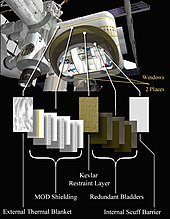Transhab


TransHab was a NASA concept for inflatable living modules in space . The concept was developed in the 1990s at the Lyndon B. Johnson Space Center and was not made ready for use by NASA because of the high costs. The space company Bigelow Aerospace acquired the rights to the NASA patents for the TransHab and used this technology to construct the space station modules BEAM and B330 .
Historical background
NASA made its first attempts with inflatable technologies in 1960 with the spherical satellites Echo 1 and Echo 2 . The two satellites were placed in orbits at 1500 and 1200 km altitude and then inflated to a diameter of about 30 and 40 m respectively. They were then used to reflect radio waves. The diameter of Echo 1 shrank to 18 m within a year. The satellite was visible for 8 years until it burned up.
The first ideas for inflatable living modules arose when NASA engineers were working on space station constructions. One of these designs was the Erectable Torus Manned Space Laboratory by a team at the Langley Research Center . The torus should have a diameter of about 7 m and was designed and built true to scale by Goodyear as a test version (earth application). At the time, however, the developers had concerns about the torus being perforated by micrometeorites . The stability of the torus during docking maneuvers or movements of people and equipment inside was also called into question.
Another concept developed by Langley scientists during this time was a hexagonal space station made up of six rigid modules connected to a non-rotating central module with inflatable spokes. The station should be approximately 23 m in diameter and rotate slowly. The central module should be used for docking space ships and for research work.
With the start of the Apollo program , work gradually stopped. The last tests showed that the hexagonal space station with its rigid modules and walls has a considerable advantage in terms of heat radiation behavior and micrometeorite protection compared to the torus shape. The thermal radiation behavior was tested in a thermal vacuum chamber for several months. It turned out that the walls of the rigid modules have a better insulating effect than the material of the torus. With regard to the protection against micrometeorites, no qualitative statements could be made, since at that time no test facilities existed that could have generated the speeds.
The TransHab concept
The name TransHab is an abbreviation for "Transit Habitat". The name refers to one of the original ideas for use, namely the use as a living module of a spaceship for a flight to Mars. The second possibility was the use on the ISS, as it was later realized by Bigelow with BEAM. In addition, the concept should prove that such inflatable modules are also suitable for habitats on the surface of Mars. The concept describes:
- the outer shell, consisting of several layers:
- "External Thermal Blanket" - an outer thermal insulation layer
- "MOD Shielding" - protective layers against micrometeorite and space debris
- “Kevlar Restraint Layer” - a high tensile strength layer that limits the expansion and thus determines the shape
- "Redundant Bladders" - several layers of gas-tight bubbles to hold the atmosphere
- "Internal Scuff Barrier" - the innermost layer of stress that is touched by the user
- the core structure with:
- a tunnel structure made of CFRP material
- several corridors, bulkheads (floor and ceiling) and several entrances to various levels
- a water tank that runs around the crew quarters as radiation protection
- a docking mechanism
- a non-pressurized tunnel in which u. a. the compressed air tanks for the deployment process are located.
The TransHab concept for the ISS envisaged a pressurized volume of 342 m 3 . This should consist of 4 levels, the docking level and the living and working levels. When determining the height of the levels, the type of use was taken into account, so levels 1 and 3 would be around 2.4 m high and level 2 only 2.1 m. Level 2 would therefore be used as a storage location and for the crew quarters, whereas Level 1 would serve as a meeting place for social or professional interaction and Level 3 as a medical and sporting activity area. Both levels should have observation windows to see the earth or into space.
See also
Web links
- bigelowaerospace.com
- Kriss J. Kennedy: TransHab and the space architects. Fabric Architecture, September 1999, archived from the original on November 7, 2014 ; accessed on March 26, 2011 (English).
- Dan Schrimpsher: Interview: TransHab developer William Schneider. The Space Review, August 21, 2006, accessed March 26, 2011 .
- Harley A. Thronson et al .: Review of US Concepts for Post-ISS Space Habitation Facilities and Future Opportunities. (PDF) AAIA, 2010, accessed on March 3, 2011 (English).
swell
- ^ A b c Kriss J. Kennedy: Lessons from TransHab - AN ARCHITECT'S EXPERIENCE. (PDF; 2.9 MB) AIAA Space Architecture Symposium, October 10, 2002, accessed on March 8, 2011 (English).
- ↑ Doug Messieron: NASA Proposes License Grant for Bigelow Technology. parabolicarc.com, February 22, 2011, accessed March 16, 2011 .
- ↑ a b c SP-4308 SPACEFLIGHT REVOLUTION - Skipping "The Next Logical Step". nasa.gov, accessed March 9, 2011 .
- ↑ Kim Dismukes (curator): TransHab Concept. nasa.gov, June 27, 2003, accessed March 16, 2011 .

